 To enhance service speed and avoid tariff delays, we've opened a US warehouse. All US orders ship directly from our US facility.
To enhance service speed and avoid tariff delays, we've opened a US warehouse. All US orders ship directly from our US facility.
| Cat. No. | Product Name | Field of Application | Chemical Structure |
|---|---|---|---|
| DC76253 | ZINC43120769 |
ZINC43120769 is a PARP1 inhibitor. ZINC43120769 can be used in prostate cancer (PC) research.
More description
|

|
| DC76252 | ZINC20906412 |
ZINC20906412 is a poly(ADP-ribose) polymerase-10 (PARP10) inhibitor. ZINC20906412 can be used for the research of cancer.
More description
|

|
| DC76251 | TDI-012804 |
TDI-012804 is a TNKS2 inhibitor that selectively inhibits intracellular endogenous TNKS2 protein. TDI-012804 increases the expression of AXIN1 protein in cells that are heterozygous (Tnks1HET) and completely knocks out (Tnks1KO) for TNKS1. TDI-012804 inhibits the proliferation of ApcQ1405X/Tnks1KO organoids (EC50 of 59.1 nM) and is selectively toxic to Tnks1KO AKP-G12D and AKP-G13D organoids.
More description
|

|
| DC76250 | KU-0058948 |
KU-0058948 is a specific and potent PARP1 inhibitor with an IC50 of 3.4 nM. KU-0058948 induces cell cycle arrest and apoptosis of primary myeloid leukemic cells and myeloid leukemic cell lines.
More description
|

|
| DC76249 | Itareparib |
Itareparib is the inhibitor for PARP and exhibits antineoplastic activity.
More description
|

|
| DC76248 | EAPB0503 |
EAPB0503 is a quinoline compound with anti-tumor activity, showing strong cytotoxicity against melanoma cells in vitro (IC50=200 nM). EAPB0503 can induce specific cell cycle arrest in mitosis of CML cells and directly activate apoptosis, leading to an increase in the G0 cell population, disruption of mitochondrial membrane potential, PARP cleavage, and DNA fragmentation. EAPB0503 also reduces the levels of BCR-ABL protein .
More description
|

|
| DC76247 | BSI-401 |
BSI-401 is an orally active PARP-1 inhibitor. BSI-401 alone and in synergism with Oxaliplatin. Ocifisertib hydrochloride is an orally active PLK4 inhibitor with a Ki and an IC50 of 0.26 nM and 2.8 nM. Ocifisertib hydrochloride inhibits growth of various cancer cells, arrests cell cycles at G2/M phase, and induces apoptosis. Ocifisertib hydrochloride exhibits antitumor efficacy in mouse model.
More description
|

|
| DC76246 | Benadrostin |
Benadrostin is a Poly(ADP-ribose) synthetase inhibitor with an IC50 of 35 μM.
More description
|

|
| DC76245 | ARCher-142 |
ARCher-142 (compound S8) is a potent tankyrase inhibitor. ARCher-142 selectively binds to ARC4 with potency of 8 µM.
More description
|

|
| DC76244 | (rac)-Talazoparib |
(rac)-Talazoparib ((rac)-BMN-673) (Compound 47) is the orally active inhibitor for PARP1/2 with Ki of 1.2 nM and 0.87 nM. (rac)-Talazoparib inhibits cellular PARylation with an EC50 of 2.51 nM. (rac)-Talazoparib causes the accumulation of DNA damage, inhibits proliferation of BRCA1/2-mutated MX-1 cell and Capan-1 cell with IC50 of 0.3 nM and 5 nM. (rac)-Talazoparib exhibits antitumor efficacy in mouse models.
More description
|

|
| DC73217 | Thioparib Featured |
Thioparib is a next-generation potent, orally bioavailable pan-PARP inhibitor with IC50 of 0.13/0.006 nM (PARP1/2), overcomes multiple PARPi resistance both in vitro and in vivo.
More description
|
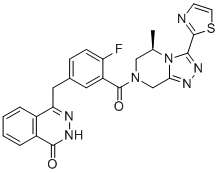
|
| DC1037 | AZD2461 Featured |
AZD2461 is indeed a novel poly (ADP-ribose) polymerase (PARP) inhibitor that has been investigated for its potential to overcome resistance mechanisms associated with other PARP inhibitors, such as Olaparib. One of the key resistance mechanisms to Olaparib is mediated by P-glycoprotein (Pgp), an efflux pump that can reduce intracellular concentrations of the drug, thereby diminishing its efficacy.
More description
|
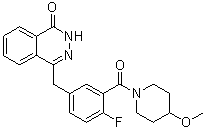
|
| DC72591 | OUL232 Featured |
OUL232 is a potent inhibitor of mono-ARTs PARP7, PARP10, PARP11, PARP12, PARP14, and PARP15. OUL232 is the most potent PARP10 inhibitor described to date (IC50=7.8 nM), as well as the first PARP12 inhibitor ever reported.
More description
|

|
| DC11022 | OUL35 Featured |
OUL35 (NSC39047) is a potent and selective inhibitor of mono-ADP-ribosyltransferase PARP10/ARTD10 with IC50 of 330 nM, displays remarkable selectivity towards ARTD10 over other enzymes in the human protein family.
More description
|
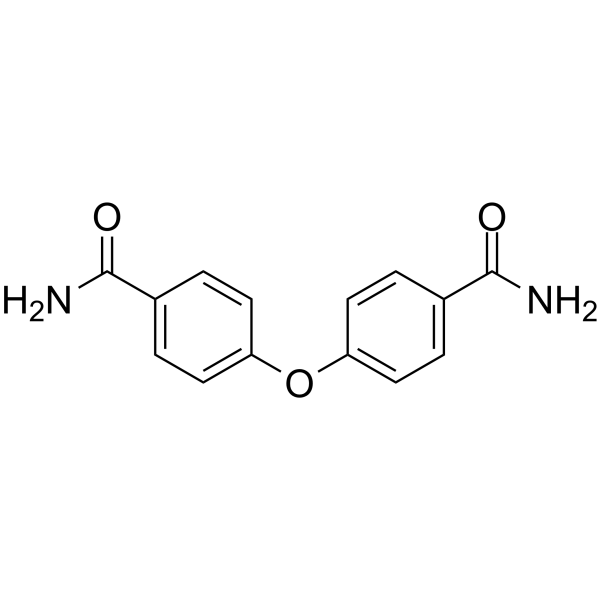
|
| DC73216 | Mortaparib Plus |
Morataprib Plus is a novel anticancer small molecule that disrupts mortalin-p53 interaction, prevents the interaction of mortalin with p53 resulting in the activation of growth arrest and apoptosis mediated by activation of p21WAF1 or BAX and PUMA signall
More description
|

|
| DC73215 | Mortaparib |
Mortaparib is a dual inhibitor of mortalin-PARP1 interaction, and a p53 activating cytotoxic compound, induces activation of growth arrest and apoptosis signaling in cancer cells in vitro and in vivo.
More description
|

|
| DC73214 | kt-3283 |
kt-3283 is a novel bi-functional PARP-HDAC inhibitor with IC50 of 0.338 nM, 2.19 nM and 1.89 uM for PARP1, PARP2 and HDACs, respectively.
More description
|

|
| DC73213 | KMR-206 |
KMR-206 (KMR206) is a potent, selective PARP7 inhibitor with IC50 of 13.7 nM, displays 75-fold selectivity for PARP7 over PARP2 and does not inhibit PARP1 up to 3 uM.
More description
|

|
| DC73212 | G-631 |
G-631 is a potent and selective TNKS1/2 inhibitor with IC50 of 7 nM in biochemical assays of tankyrase auto-PARsylation activity, and cellular potency of 8 nM (HEK293).
More description
|

|
| DC73211 | AMXI-5001 |
AMXI-5001 (AMXI 5001) is a novel, highly potent, orally active dual PARP1/2 (IC50 5/0.05 nM) and microtubule polymerization inhibitor, inhibits intracellular PAR formation with IC50 of 7 nM.
More description
|

|
| DC8453 | Talazoparib(BMN-673)tosylate Featured |
Talazoparib, also known as BMN-673 and MDV-3800, is an orally bioavailable inhibitor of the nuclear enzyme poly(ADP-ribose) polymerase (PARP) with potential antineoplastic activity (PARP1 IC50 = 0.57 nmol/L). Talazoparib acts as an inhibitor of poly ADP ribose polymerase(PARP) which aids in single strand DNA repair. Cells that have BRCA1/2 mutations are susceptible to the cytotoxic effects of PARP inhibitors because of an accumulation of DNA damage. Talazoparib is theorized to have a higher potency than olaparib due to the additional mechanism of action called PARP trapping. PARP trapping is the mechanism of action where the PARP molecule is trapped on the DNA, which interferes with the cells ability to replicate. Talazoparib is found to be ~100 fold more efficient in PARP trapping than olaparib.
More description
|

|
| DC9576 | Niraparib tosylate Featured |
MK-4827(Niraparib) tosylate is a selective inhibitor of PARP1/PARP2 with IC50 of 3.8 nM/2.1 nM; with great activity in cancer cells with mutant BRCA-1 and BRCA-2; >330-fold selective against PARP3, V-PARP and Tank1.
More description
|

|
| DC70175 | AEP07 Featured |
AEP07 (AEP 07) is a selective small molecule inhibitor of PARP4 (vPARP) inhibitor with IC50 of 0.8 uM, >12-fold selective over other PARP family members.
More description
|
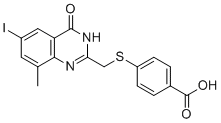
|
| DC72590 | RBN-3143 |
RBN-3143 is a potent and NAD+-competitive catalytic PARP14 inhibitor with an IC50 value of 4 nM. RBN-3143 inhibits PARP14-mediated ADP-ribosylation and stabilizes PARP14 in cell lines. RBN-3143 can be used in research of lung inflammation.
More description
|

|
| DC9246 | PJ34(free base) Featured |
PJ34 is a potent specific inhibitor of PARPl/2 with IC50 of 110 nM and 86 nM, respectively.
More description
|

|
| DC7533 | wiki4 Featured |
WIKI4 is a novel Tankyrase inhibitor with IC50 of 15 nM for TNKS2, and leads to inhibition of Wnt/beta-catenin signaling.
More description
|
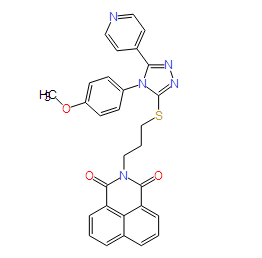
|
| DC5150 | Veliparib (ABT-888 hydrochloride) Featured |
Veliparib is a potent inhibitor of both PARP-1 and PARP-2 by [3H]NAD+ with Kis of 5.2 and 2.9 nmol/L, respectively.
More description
|

|
| DC7334 | UPF 1069 Featured |
UPF 1069 is a selective PARP2 inhibitor with IC50 of 0.3 μM; ~27-fold selective against PARP1.
More description
|
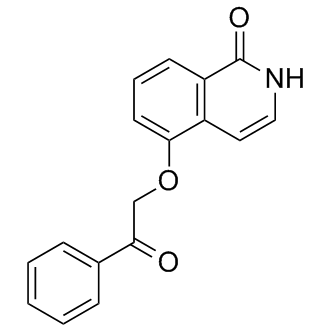
|
| DC7237 | PJ34 HCl Featured |
PJ34 HCl is the hydrochloride salt of PJ34, which is a PARP inhibitor with EC50 of 20 nM and is equally potent to PARP1/2.
More description
|

|
| DC4110 | AZD-2281 (Olaparib) Featured |
Olaparib (AZD2281, KU0059436) is a selective inhibitor of PARP1 and PARP2 with IC50 of 5 nM and 1 nM, respectively.
More description
|

|